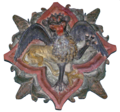Seven Memmingen landmarks
For a long time, knowledge of the seven Memmingen landmarks was considered evidence that the journeymen of the various guilds had actually completed their apprenticeship in Memmingen . Every journeyman had to be able to list these landmarks and know their meaning.
However, it is unlikely that today's landmarks are really the same as they were in the Middle Ages, as many of the buildings were not built until the Renaissance . The house with seven roofs, the green devil of St. Martin and the horse in the cradle will probably not have been one of them back then. However, there are no records of which buildings and events were previously considered landmarks. In the Memmingen archives and the surrounding cities, only the seven Memmingen landmarks are mentioned.
The seven landmarks of Memmingen include:
- The water art
- The horse in the cradle
- The basilisk
- The blue Saul
- The seven roof house
- Saint Hildegard
- The green devil of St. Martin
Landmark
The water art
The water art was a masterpiece of medieval water systems. Something remarkable was created here for the circumstances. At the entrance to the Wall , the Memminger Ach was passed over the city moat and the Wegbach continued. The water art was fastened with the water art tower. Through the construction of the railway, the draining of the moats around the city and the demolition of the city wall, the water art became superfluous, so that it fell victim to the demolition in 1862. Only a water trap still reminds of the pioneering work of the builders of the time.
The horse in the cradle
This is the story of a seemingly dead wife: a grave digger wanted to steal the jewelry from a fresh grave. When he took off the lid of the coffin, the woman who had believed dead stood up and asked: "What do you want?" The gravedigger fled in horror. The supposedly dead woman went home. Her husband couldn't believe his eyes and told her that she couldn't be his wife, "as little as my horse is in the cradle". The two looked. Lo and behold: The horse was actually in the cradle. The man then let the woman into the house and the two spent more happy years together. As a memento, according to legend, the man had the painting attached to his house. It is said that the painting must never fade, otherwise the woman should haunt the house .
The basilisk
The basilisk was also up to mischief in Memmingen . He is said to have lived in a house on Hinteren Gerbergasse . It is also called the dragon behind the angel , which can be traced back to the Gasthaus Engel in the Hirschgasse in front of it. It is assumed that the fossilized basilisk that can be seen in the city museum was a keystone of the vault of the Schottenkloster, which was demolished in the 16th century.
The legend has a true core. The lavatory pits in the basement of all houses had to be cleaned every three to four years. But this was often neglected by the residents of the houses. Due to the gases that formed, people often died due to “mysterious circumstances”. The basilisk was blamed for this.
The blue Saul
The blue Saul is a pillar on the market square, which was probably the first place of execution in the Memmingen judicial district. However, no one can say with certainty why the column is blue. There is one story, however:
One night after curfew , a councilor went home quite drunk from one of the countless wine bars. His company, whom he needed to find his way home, heard the night watchman on the market square . He leaned the drunken councilor against the pillar to distract the night watchman. When this was done, he picked up the councilor again. However, its blue condition had colored the column blue. The blue Saul is said to have existed since then .
The seven roof house
The seven-roof house was used by the tanners to dry their skins. The extraordinary architecture of the house gives it its name. It has a total of seven roofs, with the gable also counting as a roof.
Saint Hildegard
Saint Hildegard is a portrait by Bernhard Strigel on the tower of St. Martin . It was originally intended to depict the last Hohenstaufen king Conradin of Sicily, who was executed by Charles I of Anjou in Naples. However, the citizens did not recognize him, but said that it represented Hildegard , then venerated as saint , the wife of Charlemagne from Upper Swabia.
The green devil
The green devil is a no longer existing image of the devil in St. Martin's Church . It disappeared in World War II. When the roof of St. Martin was protected with fire-proof paint, the forced laborers and prisoners of war painted the fresco on the front wall of the choir with this paint as well. Thereby the devil was lost forever. However, there are other devils in St. Martin (the white, the stone, the wooden and others). The portrait must have looked something like that in the collegiate church of Holzgünz . The painter of the red devil in Holzgünz and that of the green devil in St. Martin both came from the artist family Sichelbein in Memmingen.
- gallery
The seven roof house
literature
- Uli Braun: About the Green Devil and Saint Hildegard. Of the seven landmarks in Memmingen . Verlag der Memminger Zeitung, Memmingen 1994, ISBN 3-934509-29-0 .
Web links
- Memmingen landmark Allgäu-Lexikon







